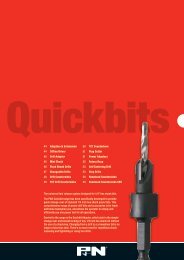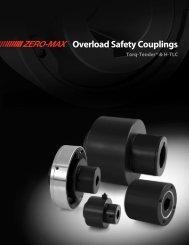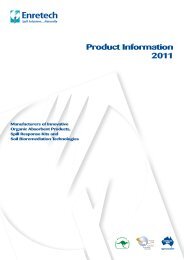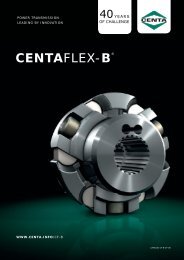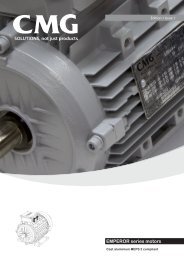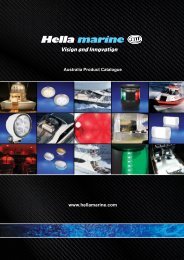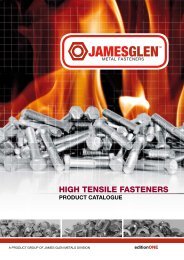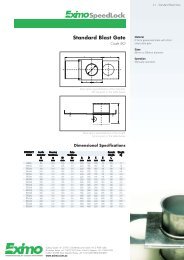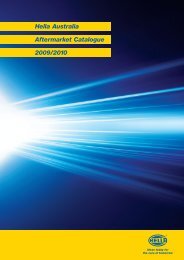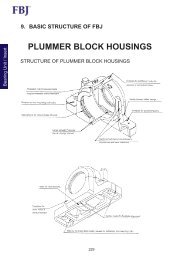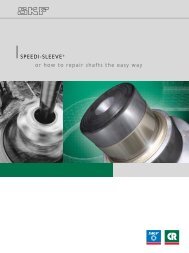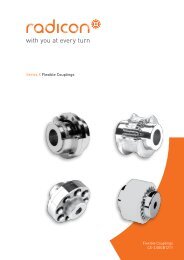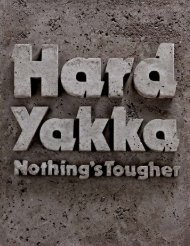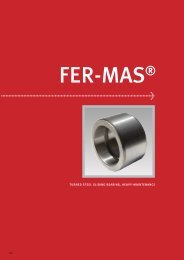aqueous cleaners - Industrial and Bearing Supplies
aqueous cleaners - Industrial and Bearing Supplies
aqueous cleaners - Industrial and Bearing Supplies
Create successful ePaper yourself
Turn your PDF publications into a flip-book with our unique Google optimized e-Paper software.
glossary of termsBiodegradableA substance that is capable of being broken downinto harmless products by the action of living things.The rate at which compounds may be chemicallybroken down by bacteria <strong>and</strong>/or natural environmentalfactors.Brittle PointTemperature at which a material breaks under definedconditions of deformation.Class I Ozone DepletersChlorinated solvents including carbon tetrachloride, 1,1, 1-Trichloroethane <strong>and</strong> CFCs (Freon). Since 1993,these products have required special labeling <strong>and</strong> havebeen banned from manufacture by the EPA.Class II Ozone DepletersProducts that contain HCFCs like HCFC-141b <strong>and</strong>HCFC-225. The production <strong>and</strong> importation phase outdate is January 1, 2003 <strong>and</strong> January 1, 2015 respectively.Dielectric StrengthThe minimum electrical gradient that a material canwithst<strong>and</strong> without decomposition usually specified involts per millimeter of thickness. Also known as thebreakdown voltage.Elongation PercentDirectly related to Tensile Strength. Elongation is thedeformation that results from the application of a tensileforce <strong>and</strong> is calculated as the change in length dividedby the original length.EmulsionA mixture of water-soluble <strong>and</strong> water-insoluble groupsheld together by a surfactant. Emulsions are usuallymilky white.Extremely FlammableAs defined by the Consumer Products SafetyCommission, a substance with a flashpoint at or below20˚F as determined by Tagliabue Open Cup Tester. Or,for an aerosol, if the flame travels back to the actuator<strong>and</strong> the flashpoint is at or below 20°F.Falex TestA method for determining the extreme pressure(EP) or anti-wear properties of oils <strong>and</strong> greases. Veeblocks (with large “V-shaped notch) are placed onopposite sides of rotating steel shaft, <strong>and</strong> the apparatusis immersed in the test lubricant. Load is automaticallyincreased until seizure occurs. Measurable wear scarsare formed on the blocks.FerrousMetals related to or containing iron.FlammableCapable of catching fire easily <strong>and</strong> burning rapidly.OSHA defines flammable liquids as having a flashpointbelow 100˚F.Flash PointThe lowest temperature of a liquid or solid at which itgives off vapors that will ignite but not continue toburn when a small flame is periodically passed over thesurface.GallingDestructive wear of a metal surface characterized bylarge chunks of metal being removed.KB ValueThe Kauri Butanol (KB) value is a measure of thesolvent power of a hydrocarbon liquid. Kauri gumis readily soluble in butanol but insoluble inhydrocarbons. The KB value is the measure of thevolume of solvent required to produce turbidity in ast<strong>and</strong>ard solution containing kauri gum dissolved inbutanol. The higher the KB value, the more powerfulthe solvent.NLGI GradeNational Lubricating Grease Institute. A commonreference to the measure of used consistency of aparticular grease. The most common consistencynumber is #2. Softer grades, especially #0 <strong>and</strong> #1, areoften used for improved pumpability or low-temperatureservice. High consistency numbers, #3 through #6 areused for certain high-speed bearings where leakage <strong>and</strong>sealing are particular concerns.NSF RatingNational Sanitation Foundation RegistrationProgram for Proprietary Substances <strong>and</strong> NonfoodCompounds. This program mirrors the prior USDAprogram. Product evaluation is based on formulation<strong>and</strong> label review. Approved products receive a Letter ofAuthorization <strong>and</strong> are included on the List of ProprietarySubstances <strong>and</strong> Nonfood Compounds.Non-FerrousMetals that contain no iron.ODCsOzone Depleting Compounds. Substances thatcontribute to the deterioration of the ozone. There aretwo types of ODCs: Class I <strong>and</strong> Class II ozone depleters.Class I ODCs are the most harmful to the ozone.Currently listed as Class I ODCs are chlorofluorocarbons(CFCs), carbon tetrachloride, <strong>and</strong> 1,1,1-Trichloroethane.Class II ODCs are less harmful but still pose a threat.Currently listed as Class II ODCs are HCFCs.OTC STATESOzone Transport Commission. As of January 1, 2010,the following states have adopted the OTC Model Ruleregulating VOC’s in consumer products: Connecticut,Delaware, District of Columbia, Illinois, Maine,Maryl<strong>and</strong>, Massachusetts, Michigan, New Hampshire,New Jersey, New York, Ohio, Pennsylvania, Rhode Isl<strong>and</strong><strong>and</strong> parts of VirginiapHA scale ranging from 0 to 14 used to measure acidity<strong>and</strong> alkalinity. The lower the number the more acidic;the higher the number, the more alkaline; 7 is neutral.psiPound per Square Inch. A unit of pressure equal tothe pressure resulting from a force of 1 pound applieduniformly over an area of 1 square inch.SAESociety of Automotive Engineers.SubstrateThe surface being cleaned; the substrate may be metal,plastic, ceramic, etc.SurfactantA specialized molecule that connects water soluble <strong>and</strong>water-insoluble groups.Tensile StrengthThe strength of different metals to support differentloads (masses) before going through the point at whichthey change from being elastic to being plastic. Thetensile strength test measures the elastic <strong>and</strong> plasticproperties of metal.Timken OK LoadThe highest load than can be applied without abrasivewear to a rotating test cup containing a grease sample.The higher the OK number, the better protection agrease provides under severe service. The highest numbertypically given to any sample is 80.ViscosityThe resistance to flow or degree of thickening fluid.Flow requires stress; liquids such as additive-free lubricatingoils are known as Newtonian fluids in that shearrate is proportional to the pressure or stress applied.This proportion is the coefficient of viscosity.VOCsVolatile Organic Compounds. A class of chemicalsthat contain carbon <strong>and</strong> have the potential to formground-level ozone (smog). Many common items includinggasoline, oil-based paints <strong>and</strong> alcoholsproduce VOCs.74 Customer Service: (800) 272-4620 • Technical Assistance: (800) 521-3168 More product information a click away at www.crcindustries.com/ei



